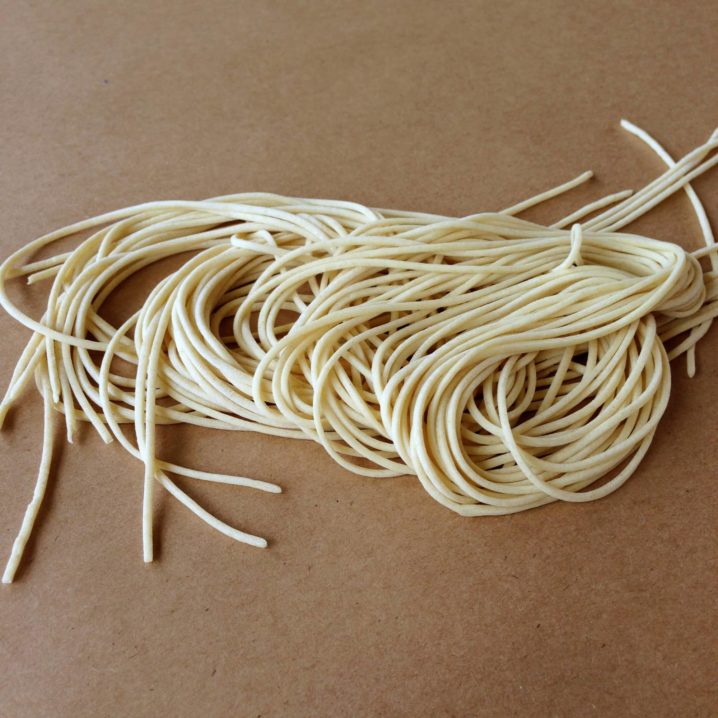
- POPSUGAR Australia
- Living
- 10 Things You Don’t Know About Ramen Noodles
10 Things You Don’t Know About Ramen Noodles

POPSUGAR Studios
There’s a whole wide world of ramen knowledge to know and we’re here to share some invaluable facts about the Japanese noodles from Thy Tran (of the Wandering Spoon) and Ken Tominaga (Pabu SF’s ramen chef). The two shared their tips for making and eating ramen. No. 9 is essential, be forewarned.
Five Things to Know About Making Homemade Ramen
- Ramen doesn’t get its yellow color from eggs: A traditional ramen recipe consists of hot water, kansui, salt, and wheat flour. No egg!
- Kansui is everything: Traditionally, ramen noodles were made using well water, which is naturally alkaline. Today, recipes call for kansui, an alkaline, mineral-rich water sold in Asian markets. The kansui reacts with the flour to give ramen its yellow color, springy texture, and earthy (borderline funky) scent. It may also be labeled as potassium carbonate or sodium hydroxide.
- More gluten equals more chew: For a chewier ramen noodle, use a higher-protein (gluten) flour. Use 00 flour (a finely ground flour) for a silkier noodle.
- Coat the noodles in potato starch: To keep the noodles from sticking together as you cut them, liberally sprinkle them with potato starch.
- Cook them in the biggest pot you own: Bring a (very!) large pot of salted water to a boil. To keep the noodles from sticking together, delicately sprinkle them in. They need lots of room to “dance.”
Five Things to Know About Eating Ramen
- Don’t talk while eating: In Japanese ramen shops, talking is forbidden while eating a bowl of ramen. Men and women sit in silence, reverentially eating their bowls to respect and reflect on the hard work the ramen maker has undertaken to create such an edible masterpiece.
- Start with the broth: Ramen houses painstakingly cook broths for hours. To observe the broth’s nuances, sip a few spoonfuls of the broth before diving into the ramen noodles.
- Eat fast: There’s only one speed to eat ramen, and that’s fast. Ramen noodles continue to cook in the hot broth they are served in, and nothing is sadder than a mushy, overcooked clump of ramen.
- Slurp loudly: In order to eat quickly without burning yourself, slurping simultaneously cools the noodles while jetting them down your throat.
- Pair with beer: An Asian lager like Sapporo pairs effortlessly with ramen. The bubbles and dry flavor cut through the fat and spice of the ramen broth.
Homemade Ramen Noodles
From Thy Tran, Fine Cooking
Ingredients
- 1 cup hot water
2 tablespoons kansui
1 teaspoon salt
3 1/2 cups 00 flour or unbleached all-purpose flour
Potato starch
Directions
- Stir together the hot water, kansui, and salt in a medium bowl until dissolved.
- Put the flour into a food processor fitted with the dough blade; pulse a few times. With the machine running, drizzle in about 3/4 cup of the kansui mixture toward the edge of the food processor. Stop to squeeze the dough and incorporate any clumps of dry flour. Continue mixing in the water 1 teaspoon at a time just until the dough forms small, distinct balls that, when squeezed, meld into a smooth mass. Knead by machine for 3 minutes, then finish kneading by hand for 2 minutes.
- Shape the dough into a smooth square, wrap in plastic, and let rest for at least 1 hour or refrigerate for up to 1 day. Remove from fridge, and allow to come to room temperature before rolling out.
- Cut the dough into four even pieces with a knife. Using a pasta machine, pass each piece through the rollers, starting with setting 1 and working through to setting 5. Coat the dough sheets well with potato starch to prevent sticking, and then pass noodles through the thin-width cutters. Dredge the noodles evenly with more potato starch.
- Cook immediately for 1 minute in a large stockpot filled with boiling salted water, or wrap well and refrigerate for up to 3 days.
Information
- Category
- Pasta, Main Dishes
- Cuisine
- Japanese
- Yield
- 24 ounces uncooked noodles, or 6 servings


